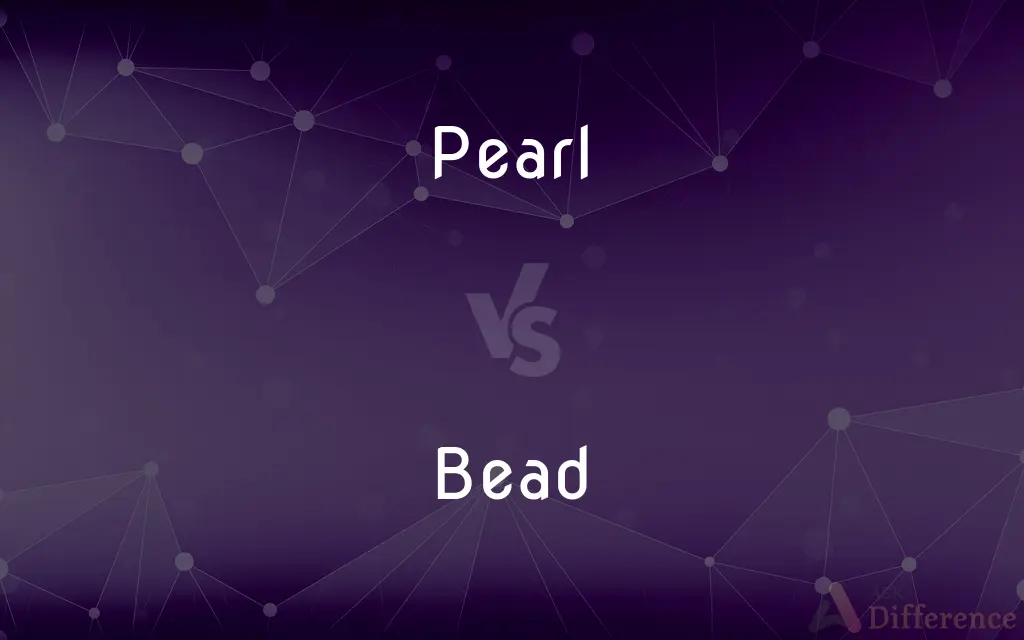Pearl vs. Bead — What's the Difference?
By Urooj Arif & Maham Liaqat — Updated on April 5, 2024
Pearls are natural or cultured gems formed inside mollusks, prized for their luster and rarity. Beads are small, decorative objects made from various materials, used in crafting and jewelry.

Difference Between Pearl and Bead
Table of Contents
ADVERTISEMENT
Key Differences
Pearls are organic gems produced within the soft tissue of a living shelled mollusk. They are highly valued in jewelry for their natural luster, beauty, and rarity. On the other hand, beads are manufactured from a wide range of materials including glass, plastic, metal, and wood, serving as versatile components in jewelry making, crafts, and decorative arts. While pearls can be considered a type of bead due to their use in stringing for jewelry, their organic origin and natural formation process distinguish them from other beads.
In terms of creation, pearls form when an irritant, such as a piece of sand, becomes lodged in a mollusk, prompting the creature to secrete layers of nacre around the irritant over time. This process can take several years, resulting in the pearl’s unique luster and color. Conversely, beads are typically crafted through various human-made processes, including molding, carving, and shaping, allowing for a broader variety of sizes, shapes, and colors.
The value of pearls is determined by several factors including their luster, size, shape, color, and the type of pearl (natural, cultured, freshwater, or saltwater). Natural pearls are particularly rare and expensive due to overfishing and pollution affecting their production. Beads, however, can range widely in value depending on the material from which they are made, with some beads made of precious stones or metals being highly valuable, while others made of common or synthetic materials are far more affordable.
Pearls have been symbols of purity, wealth, and status, often featured in royal and ceremonial jewelry. Beads have also held significant cultural and historical importance across various civilizations, used not only as adornments but also as currency, symbols of status, and objects with religious or spiritual significance.
While the allure of pearls lies in their natural beauty and the uniqueness of each piece, beads offer endless creative possibilities due to their variety in material, color, and shape. This makes beads essential elements in the creation of diverse and intricate jewelry designs, whereas pearls often stand alone or are combined with other precious gems and metals in fine jewelry.
ADVERTISEMENT
Comparison Chart
Origin
Organic, formed inside mollusks
Manufactured from various materials
Formation Process
Natural process involving nacre deposition around an irritant
Crafted through molding, carving, and shaping
Value Determinants
Luster, size, shape, color, type
Material, rarity, craftsmanship
Cultural Significance
Symbols of purity, wealth, status
Used in adornments, currency, symbols of status, religious objects
Uses in Jewelry
Often stand alone or with precious gems
Integral in diverse jewelry designs, crafting
Compare with Definitions
Pearl
A precious thing; the finest example of something.
The old library was considered a pearl among the city's cultural landmarks.
Bead
Components used in making jewelry, decorations, and embroidery.
She sifted through her collection of colorful beads to find the perfect ones for her project.
Pearl
A hard, lustrous spherical mass, typically white or bluish-gray, formed within the shell of a pearl oyster or other bivalve mollusk.
She wore a necklace adorned with a single, luminous pearl.
Bead
A small, decorative object that is formed in a variety of shapes and sizes of a material such as stone, bone, shell, glass, plastic, wood, or pearl and that is pierced for threading or stringing.
The artisan crafted a vibrant necklace using beads of glass and wood.
Pearl
Symbol of purity and elegance in jewelry.
Pearls have been a symbol of elegance for centuries, gracing the necks of royalty and celebrities.
Bead
Objects used for counting or praying, especially in rosaries.
Each bead on the rosary represented a prayer to be recited.
Pearl
Natural or cultured gemstones created in mollusks.
The jeweler specialized in setting both natural and cultured pearls.
Bead
A small, often round piece of material used in decorative or functional applications.
The dress was embellished with tiny silver beads.
Pearl
Organic gem characterized by its lustrous sheen.
The pearl's unique luster is due to layers of nacre, secreted by the mollusk over time.
Bead
Materials of varying origins and values used in crafts.
The craft store offered beads ranging from cheap plastic to expensive gemstones.
Pearl
A pearl is a hard, glistening object produced within the soft tissue (specifically the mantle) of a living shelled mollusk or another animal, such as fossil conulariids. Just like the shell of a mollusk, a pearl is composed of calcium carbonate (mainly aragonite or a mixture of aragonite and calcite) in minute crystalline form, which has deposited in concentric layers.
Bead
A bead is a small, decorative object that is formed in a variety of shapes and sizes of a material such as stone, bone, shell, glass, plastic, wood or pearl and with a small hole for threading or stringing. Beads range in size from under 1 millimetre (0.039 in) to over 1 centimetre (0.39 in) in diameter.
Pearl
A hard, lustrous spherical mass, typically white or bluish-grey, formed within the shell of a pearl oyster or other bivalve mollusc and highly prized as a gem
A linen garment decorated with pearls
A pair of pearl earrings
Necklaces of amethyst and pearl
Bead
A small, often round piece of material, such as glass, plastic, or wood, that is pierced for stringing or threading.
Pearl
A person or thing of great worth
He has some pearls of wisdom to offer
Bead
Beads A necklace made of such pieces.
Pearl
Another term for picot
Bead
Beads Roman Catholic Church A rosary.
Pearl
Form drops resembling pearls
Raindrops pearled on water-soaked windowpanes
Bead
Often beads(Obsolete) A prayer.
Pearl
Dive or fish for pearl oysters
The pearling industry
Bead
A drop of moisture
Beads of sweat.
Pearl
A smooth, lustrous, variously colored mass, chiefly of calcium carbonate, formed around a grain of sand or other foreign matter inside the shell of certain bivalve mollusks and valued as a gem.
Bead
A bubble of gas in a liquid.
Pearl
A bead resembling one of these masses.
Bead
A small metal knob on the muzzle of a firearm, such as a rifle, used for sighting.
Pearl
Something small and spherical in shape
"pearls of sweat beading on her upper lip" (Katherine Min).
Bead
A strip of material, usually wood, with one molded edge placed flush against the inner part of a door or window frame.
Pearl
Mother-of-pearl; nacre.
Bead
A decoration consisting of a usually continuous series of small spherical shapes, as on a convex molding.
Pearl
One that is highly regarded for its beauty or value.
Bead
Beading.
Pearl
(Printing) A type size measuring approximately five points.
Bead
A projecting rim or lip, as on a pneumatic tire.
Pearl
A yellowish white.
Bead
A line of continuously applied ductile material, such as solder or caulking compound.
Pearl
To decorate or cover with pearls or beads resembling pearls.
Bead
(Chemistry) A globule of fused borax or other flux used in a bead test.
Pearl
To make into the shape or color of pearls.
Bead
To furnish with or collect into beads.
Pearl
To dive or fish for pearls or pearl-bearing mollusks.
Bead
(archaic) Prayer, later especially with a rosary.
Pearl
To form beads resembling pearls.
Bead
Each in a string of small balls making up the rosary or paternoster.
Pearl
Variant of purl2.
Bead
A small, round object.
Pearl
A shelly concretion, usually rounded, and having a brilliant luster, with varying tints, found in the mantle, or between the mantle and shell, of certain bivalve mollusks, especially in the pearl oysters and river mussels, and sometimes in certain univalves. It is usually due to a secretion of shelly substance around some irritating foreign particle. Its substance is the same as nacre, or mother-of-pearl. Round lustrous pearls are used in jewellery.
Bead
A small, round object with a hole to allow it to be threaded on a cord or wire, particularly for decorative purposes.
Pearl
(figuratively) Something precious.
Bead
Various small, round solid objects.
Pearl
A capsule of gelatin or similar substance containing liquid for e.g. medicinal application.
Bead
A small drop of water or other liquid.
Beads of sweat
Pearl
Nacre, or mother-of-pearl.
Bead
A bubble, in spirits.
Pearl
A whitish speck or film on the eye.
Bead
A small, round ball at the end of a barrel of a gun used for aiming.
Pearl
A fish allied to the turbot; the brill.
Bead
(heading) A ridge, band, or molding.
Pearl
A light-colored tern.
Bead
A rigid edge of a tire that mounts it on a wheel; tire bead.
Pearl
One of the circle of tubercles which form the bur on a deer's antler.
Bead
(architecture) A narrow molding with semicircular section.
Pearl
The size of type between diamond and agate, standardized as 5-point.
Bead
A glassy drop of molten flux, as borax or microcosmic salt, used as a solvent and color test for several mineral earths and oxides, as of iron, manganese, etc., before the blowpipe.
The borax bead;
The iron bead, etc.
Pearl
A fringe or border.
Bead
(intransitive) To form into a bead.
The raindrops beaded on the car's waxed finish.
Pearl
(obsolete) A jewel or gem.
Bead
(transitive) To apply beads to.
She spent the morning beading the gown.
Pearl
(figurative) A valuable little nugget of information; especially, an aphorism or tip#Etymology 5 that is operationally useful for decision-making.
Pearl of wisdom
Clinical pearls
Bead
(transitive) To form into a bead.
He beaded some solder for the ends of the wire.
Pearl
The clitoris.
Bead
(transitive) To cause beads to form on (something).
Pearl
To set or adorn with pearls, or with mother-of-pearl.
Bead
A prayer.
Pearl
(transitive) To cause to resemble pearls in shape; to make into small round grains.
To pearl barley
Bead
A little perforated ball, to be strung on a thread, and worn for ornament; or used in a rosary for counting prayers, as by Roman Catholics and Mohammedans, whence the phrases to tell beads, to be at one's beads, to bid beads, etc., meaning, to be at prayer.
Pearl
(transitive) To cause to resemble pearls in lustre or iridescence.
Bead
Any small globular body
Pearl
(intransitive) To resemble pearl or pearls.
Bead
To ornament with beads or beading.
Pearl
(intransitive) To hunt for pearls
To go pearling
Bead
To form beadlike bubbles.
Pearl
To sink the nose of one's surfboard into the water, often on takeoff.
Bead
A small ball with a hole through the middle
Pearl
Of the nose of the surfboard: to sink in this manner.
Bead
A shape that is small and round;
He studied the shapes of low-viscosity drops
Beads of sweat on his forehead
Pearl
A fringe or border.
Bead
A beaded molding for edging or decorating furniture
Pearl
A shelly concretion, usually rounded, and having a brilliant luster, with varying tints, found in the mantle, or between the mantle and shell, of certain bivalve mollusks, especially in the pearl oysters and river mussels, and sometimes in certain univalves. It is usually due to a secretion of shelly substance around some irritating foreign particle. Its substance is the same as nacre, or mother-of-pearl.
Bead
Form into beads, as of water or sweat, for example
Pearl
Hence, figuratively, something resembling a pearl; something very precious.
I see thee compassed with thy kingdom's pearl.
And those pearls of dew she wears.
Bead
Decorate by sewing beads onto;
Bead the wedding gown
Pearl
Nacre, or mother-of-pearl.
Bead
String together like beads
Pearl
A fish allied to the turbot; the brill.
Pearl
A light-colored tern.
Pearl
One of the circle of tubercles which form the bur on a deer's antler.
Pearl
A whitish speck or film on the eye.
Pearl
A capsule of gelatin or similar substance containing some liquid for medicinal application, as ether.
Pearl
A size of type, between agate and diamond.
Pearl
Of or pertaining to pearl or pearls; made of pearls, or of mother-of-pearl.
Pearl
To set or adorn with pearls, or with mother-of-pearl. Used also figuratively.
Pearl
To cause to resemble pearls; to make into small round grains; as, to pearl barley.
Pearl
To resemble pearl or pearls.
Pearl
To dive or hunt for pearls; as, to go pearling.
Pearl
A smooth lustrous round structure inside the shell of a clam or oyster; much valued as a jewel
Pearl
A shade of white the color of bleached bones
Pearl
A shape that is small and round;
He studied the shapes of low-viscosity drops
Beads of sweat on his forehead
Pearl
Gather pearls, from oysters in the ocean
Common Curiosities
Can pearls be considered beads?
Yes, when used in stringing for jewelry, pearls are a type of bead due to their shape and function.
What materials are beads made from?
Glass, plastic, metal, wood, and even pearls, among others.
What is the key difference between a pearl and a bead?
Pearls are natural or cultured gems from mollusks, while beads are crafted from various materials.
Why are pearls valuable?
Due to their luster, rarity, and the natural process required to form them.
Do pearls require special care?
Yes, they are sensitive to chemicals and acids, and should be stored and cleaned carefully.
Are all pearls white?
No, pearls can vary in color from white to black, depending on the type of mollusk and water conditions.
What makes natural pearls especially rare?
Overfishing and pollution have significantly reduced the number of oysters capable of producing them.
How are pearls formed?
By the deposition of nacre around an irritant inside a mollusk's shell.
Can beads have cultural significance?
Yes, beads have been used as symbols of status, currency, and spiritual objects in various cultures.
What determines the value of a bead?
The material, craftsmanship, and rarity of the bead.
Can beads be used for purposes other than jewelry?
Yes, including in garments, accessories, and decorative arts.
What is the significance of bead shapes?
Shapes can influence the design and aesthetic appeal of the jewelry or craft item.
How are beads used in jewelry making?
As components for creating diverse designs, either strung together or used as accents.
Why might someone choose beads over pearls in jewelry making?
For their variety, affordability, and creative potential in diverse jewelry designs.
How do cultured pearls differ from natural pearls?
Cultured pearls are human-initiated inside farmed mollusks, whereas natural pearls form without human intervention.
Share Your Discovery

Previous Comparison
Fetid vs. Smelly
Next Comparison
Unlimited vs. InfiniteAuthor Spotlight
Written by
Urooj ArifUrooj is a skilled content writer at Ask Difference, known for her exceptional ability to simplify complex topics into engaging and informative content. With a passion for research and a flair for clear, concise writing, she consistently delivers articles that resonate with our diverse audience.
Co-written by
Maham Liaqat













































